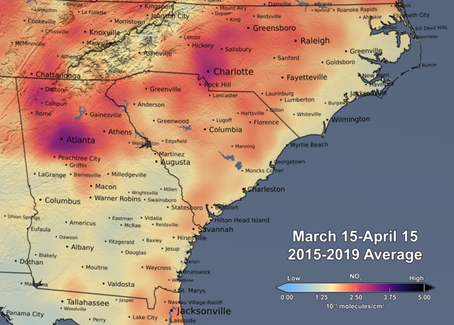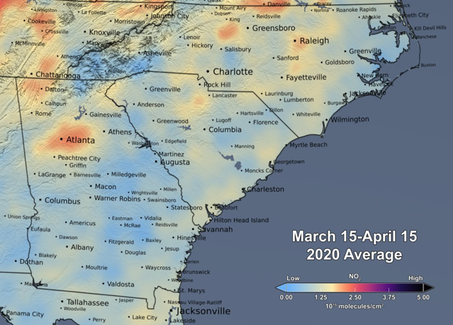By Su Bin Yoo
In an effort to slow the spread of COVID-19, countries across the world have resorted to a lockdown of varying degrees. With most people forced into stay-at-home quarantine by local governments or avoiding nonessential outings, most businesses have made the decision to temporarily close down or reduce operational capabilities.
While the shutdown has had a detrimental impact on the global economy, there is, fortunately, a silver lining in these dire times. New reports have showcased that there is a significant reduction in pollution due to the shutdown. In particular, air pollution in many regions around the globe has improved dramatically due to the pandemic. The National Aeronautics and Space Administration (NASA) reported a 30% drop in nitrogen dioxide levels over the northeastern United States (Blumberg 2020 Apr 9). The Copernicus Sentinel-5P satellite has produced multiple images and animations showing a reduction in air pollution not just in North America, but over Europe, India, and China as well as a result of the shutdown (European Space Agency 2020).
While the shutdown has had a detrimental impact on the global economy, there is, fortunately, a silver lining in these dire times. New reports have showcased that there is a significant reduction in pollution due to the shutdown. In particular, air pollution in many regions around the globe has improved dramatically due to the pandemic. The National Aeronautics and Space Administration (NASA) reported a 30% drop in nitrogen dioxide levels over the northeastern United States (Blumberg 2020 Apr 9). The Copernicus Sentinel-5P satellite has produced multiple images and animations showing a reduction in air pollution not just in North America, but over Europe, India, and China as well as a result of the shutdown (European Space Agency 2020).
Reductions in Nitrogen Dioxide Associated with Decreased Fossil Fuel Use Resulting from COVID-19 Mitigation (Credits: NASA's Scientific Visualization Studio)
UN Secretary-General António Guterres called COVID-19 to be “an unprecedented wake-up call” before the point of no return in climate change (Guterres 2020 Apr 20). Amid the dreadful outbreak, there are satirical depictions of COVID-19 as the cure that mother Earth has concocted to exterminate her own virus – humans. The remarkable change in air pollution as a result of reduced industrial activity begs a question: could this be the catalyst for a transition into a more Earth-centric economy?
However, experts warn that this silver lining is only temporary and may cause the industry to overcompensate for the lost profit after the pandemic (Worland 2020 Apr 1). The carbon dioxide levels in China are slowly rising to their normal as the lockdown is lifted and more businesses are returning to their normal operation (McMahon 2020 Mar 22). Though a shutdown is not a viable nor a favorable solution to pollution, this unprecedented global shutdown has shown that even a temporary shutdown can drastically improve greenhouse gas emission and air pollution.
While the temporary decline in air pollution may seem like a small, insignificant victory to what everyone is going through right now, air pollution is not only an isolated outcome of COVID-19 but also an inseparable part of the pandemic. Air pollution raises the risk of respiratory conditions including lung cancer and cardiovascular diseases (Bentayeb et al. 2012; Lee et al. 2014; Ferrari et al. 2020 Mar 31). CDC has announced that people of all ages with chronic lung diseases or moderate to severe asthma, and serious heart conditions are at a higher risk of severe illness from COVID-19 (CDC 2020 Feb 11). While there is no accurate number on the air pollution-related COVID-19 mortality rate, it is highly probable that air pollution played a role in exacerbating the extent of the disease through comorbidity (Wang et al. 2020; Yang et al. 2020).
Since people with underlying conditions are more susceptible to COVID-19, air pollution is deeply connected to how we arrived at a global shutdown. Even if the younger and healthier individuals are not likely to die from the disease, about 20% of the infected individuals between the ages of 20 and 44 were hospitalized and 2-4% required intensive care (CDC COVID-19 Response Team 2020). With a lower mortality rate and less threat to the labor population, the shutdown may have been more localized to those older than the age of 65 and those with severe pre-existing conditions such as immunocompromised patients. Considering the latent effects of air pollution, it may be accountable for a significant portion of comorbidity in the older population (Rabl 2003). The possibility, while very low, of lethal cases in the expanded demographic has made this pandemic a greater fiscal threat. With medicare projected to cost $2 trillion every year by 2025, the threat of insolvency comes closer as the economic cost of COVID-19 rises (Holt 2020 Apr 24). With the 14% unemployment surge in April and 30 million unemployment claims, the burden on the healthcare system is likely to spike during the pandemic (Tappe 2020 Apr 20). The short-term solution to COVID-19 right now is to develop immunity against it, and a possible long-term preventative method entails strengthening the immune system by improving public health in general.
Air pollution affects virtually everyone in the world either directly or indirectly. Despite 90% of the world’s population living in alarming levels of air pollution, efforts to reduce air pollution are not enough (Osseiran and Lindmeier 2018 May 2). Particulate pollution in the US increased by 5.5% from 2016 to 2018 after a 24% decline over 7 years (Roston 2019 Oct 22). While carbon dioxide is not considered a classic air pollutant, it has been proposed in the past to have a causal relationship with air pollution mortality, contributing up to 40% of air pollution mortality with ground-level ozone from carbon dioxide and more from raising the temperature (Jacobson 2008). Furthermore, carbon dioxide pollution can induce heat waves, forest fires, longer pollen seasons, and aggravate other natural calamities (D’Amato et al. 2014). Unfortunately, we all witnessed the sky turn red from forest fire this year during the Australian bushfire of 2019-2020 (Mao and Schraer 2020 Jan 17). During the fires, the ultrafine particle, PM2.5, levels in Sydney have been as high as 734 micrograms/m^3 (Mao and Schraer 2020 Jan 17). To put things in context, smoking a cigarette produces 20 micrograms/m^3, and Australia's clear air standard is 8 micrograms/m^3.
We have been experiencing the effects of air pollution, especially during the outbreak. Rather than reacting to the consequences of air pollution, we should address the root of the problem and eliminate the cause. It would take more than the downward trend we see now in order to fight the progression. Researchers project that some effects of carbon dioxide emission would be irreversible for 1,000 years even after completely halting carbon dioxide production (Solomon et al. 2009). Considering that a decrease in emission would not immediately halt the damages from air pollution, we must begin the transition into a more sustainable economy now.
Like any transition, there is an initial cost to transition into a green economy. Many countries are hesitant in the transition due to the short-term cost it would impose on their economy. We must look beyond the short-term cost in order to achieve sustainable growth. It has been projected that the transition to a sustainable low-carbon economic structure would save $26 trillion through 2030 for the US alone (New Climate Economy 2018). It would create over 65 million new low-carbon jobs and save 700,000 people every year from premature death due to air pollution (New Climate Economy 2018). With the amount of money being released into the market to save the economy, a concerted effort to focus on green growth during this time could mark a significant milestone during this calamity.
It is a challenging time for everyone across the world, but often the biggest changes can be made possible in chaotic situations. Since the air we breathe knows no borders, air pollution from one country can easily travel to another and affect their citizens, just as COVID-19 has. Secretary-General Guterres also emphasizes the importance of working together as an international community to address the issue (Guterres 2020 Apr 20). If we can create a united front to take bold actions against pollution, we could halt the march towards the apocalyptic fictional universe from becoming our reality.
Works Cited
European Space Agency: European Space Agency; [updated 2020; accessed 2020 May 17]. https://www.esa.int
Bentayeb M, Simoni M, Baiz N, Norback D, Baldacci S, Maio S, Viegi G, Annesi-Maesano I, Geriatric Study in Europe on Health Effects of Air Quality in Nursing Homes Group. 2012. Adverse respiratory effects of outdoor air pollution in the elderly. Int J Tuberc Lung Dis Off J Int Union Tuberc Lung Dis. 16(9):1149–1161. doi:10.5588/ijtld.11.0666.
Blumberg S. 2020 Apr 9. Data Shows 30 Percent Drop In Air Pollution Over Northeast U.S. NASA. [accessed 2020 May 17]. http://www.nasa.gov/feature/goddard/2020/drop-in-air-pollution-over-northeast.
CDC. 2020 Feb 11. Coronavirus Disease 2019 (COVID-19). Cent Dis Control Prev. [accessed 2020 May 9]. https://www.cdc.gov/coronavirus/2019-ncov/need-extra-precautions/people-at-higher-risk.html.
CDC COVID-19 Response Team. 2020. Severe Outcomes Among Patients with Coronavirus Disease 2019 (COVID-19) — United States, February 12–March 16, 2020. [accessed 2020 May 17]. https://www.cdc.gov/mmwr/volumes/69/wr/mm6912e2.htm.
D’Amato G, Cecchi L, D’Amato M, Annesi-Maesano I. 2014. Climate change and respiratory diseases. Eur Respir Rev. 23(132):161–169. doi:10.1183/09059180.00001714.
European Space Agency: European Space Agency; [updated 2020; accessed 2020 May 16]. https://www.esa.int
Ferrari R, Di Pasquale G, Rapezzi C. 2020 Mar 31. Commentary: What is the relationship between Covid-19 and cardiovascular disease?
Int J Cardiol. doi:10.1016/j.ijcard.2020.03.074. [accessed 2020 May 9]. https://www.ncbi.nlm.nih.gov/pmc/articles/PMC7138145/.
Guterres A. 2020 Apr 20. Secretary-General Says COVID-19 ‘Wake-Up Call’ Demands Recovery Built on Green Economy, Marking Earth Day 2020 | Meetings Coverage and Press Releases. [accessed 2020 May 9]. https://www.un.org/press/en/2020/sgsm20051.doc.htm.
Holt C. 2020 Apr 24. COVID-19 and the Fiscal Sustainability of Federal Health Care Programs. AAF. [accessed 2020 May 17]. https://www.americanactionforum.org/weekly-checkup/covid-19-and-the-fiscal-sustainability-of-federal-health-care-programs/.
Jacobson MZ. 2008. On the causal link between carbon dioxide and air pollution mortality. Geophys Res Lett. 35(3). doi:10.1029/2007GL031101. [accessed 2020 May 17]. https://agupubs.onlinelibrary.wiley.com/doi/abs/10.1029/2007GL031101.
Lee B-J, Kim B, Lee K. 2014. Air Pollution Exposure and Cardiovascular Disease. Toxicol Res. 30(2):71–75. doi:10.5487/TR.2014.30.2.071.
MacNicol I, Friends of the Earth Scotland. 2018. Friend of the Earth 1. [accessed 2020 May 17]. https://www.flickr.com/photos/friendsoftheearthscotland/39110187260/.
Mao F, Schraer R. 2020 Jan 17. How bad is bushfire smoke for breathing? BBC News. [accessed 2020 May 9]. https://www.bbc.com/news/world-australia-50497492.
McMahon J. 2020 Mar 22. New Satellite Video Shows China Pollution Vanishing During COVID-19 Lockdown—Then Coming Back. Forbes. [accessed 2020 May 17]. https://www.forbes.com/sites/jeffmcmahon/2020/03/22/video-watch-from-space-as-air-pollution-vanishes-over-china-during-coronavirus-lockdown-then-returns/#60993a0c35f0.
New Climate Economy. 2018. UNLOCKING THE INCLUSIVE GROWTH STORY OF THE 21ST CENTURY: ACCELERATING CLIMATE ACTION IN URGENT TIMES. New Climate Economy.
Osseiran N, Lindmeier C. 2018 May 2. 9 out of 10 people worldwide breathe polluted air, but more countries are taking action. World Health Organ. [accessed 2020 May 17]. https://www.who.int/news-room/detail/02-05-2018-9-out-of-10-people-worldwide-breathe-polluted-air-but-more-countries-are-taking-action.
Rabl A. 2003. Interpretation of Air Pollution Mortality: Number of Deaths or Years of Life Lost? J Air Waste Manag Assoc. 53(1):41–50. doi:10.1080/10473289.2003.10466118.
Roston E. 2019 Oct 22. U.S. Air Quality Was Improving. Now It’s Getting Worse. Bloomberg. [accessed 2020 May 17]. https://www.bloomberg.com/news/articles/2019-10-22/u-s-air-quality-was-improving-now-it-s-getting-worse.
Solomon S, Plattner G-K, Knutti R, Friedlingstein P. 2009. Irreversible climate change due to carbon dioxide emissions. Proc Natl Acad Sci. 106(6):1704–1709. doi:10.1073/pnas.0812721106.
Tappe A. 2020 Apr 20. 30 million Americans have filed initial unemployment claims since mid-March. CNN. [accessed 2020 May 17]. https://www.cnn.com/2020/04/30/economy/unemployment-benefits-coronavirus/index.html.
Wang B, Li R, Lu Z, Huang Y. 2020. Does comorbidity increase the risk of patients with COVID-19: evidence from meta-analysis. Aging. 12(7):6049–6057. doi:10.18632/aging.103000.
Worland J. 2020 Apr 1. Global Air Pollution Has Fallen Due to the Coronavirus Outbreak, but Experts Warn It Isn’t a Silver Lining. TIME. https://time.com/5812741/air-pollution-coronavirus/.
Yang J, Zheng Y, Gou X, Pu K, Chen Z, Guo Q, Ji R, Wang H, Wang Y, Zhou Y. 2020. Prevalence of comorbidities and its effects in patients infected with SARS-CoV-2: a systematic review and meta-analysis. Int J Infect Dis. 94:91–95. doi:10.1016/j.ijid.2020.03.017.



